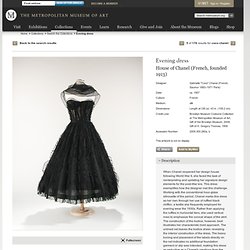

Dress, Evening. When Chanel reopened her design house following World War II, she faced the task of reinterpreting and updating her signature design elements for the post-War era.

This dress exemplifies how the designer met this challenge. Working with the conventional hour-glass silhouette of the period, Chanel marks this dress as her own through her use of ruffled black chiffon, a textile she frequently employed for evening wear the 1930s. Rather than applying the ruffles in horizontal tiers, she used vertical rows to emphasize the conical shape of the skirt.
The construction of the bodice, however, best illustrates her characteristic bold approach. The unlined net leaves the bodice sheer, revealing the interior construction of the dress.
Make up shizzz. Trendy. Art Inspired Outfits III. The Hunt. Design Crush & Tipped Out. Register - Join Now For Free. "Oyster" Dress, Irere, spring/summer 2003. Alexander McQueen (British, 1969–2010)“Oyster” DressIrere, spring/summer 2003 Ivory silk organza, georgette, and chiffon Courtesy of Alexander McQueen Photograph © Sølve Sundsbø / Art + Commerce Andrew Bolton: One of the highlights in this gallery is a dress called the “Oyster” Dress, which is made up of hundreds and hundreds of layers of silk organza, almost like a mille-feuille pastry.

And the collection told the story of a shipwreck at sea and the subsequent landfall in the Amazon, and it was peopled with pirates, conquistadors, and Amazonian Indians. And I think that what’s interesting about this particular dress is you see how McQueen evolved as a designer in terms of the fact that he was always well known as a tailor. With this particular dress, you see a much softer approach. As Sarah Burton explains: